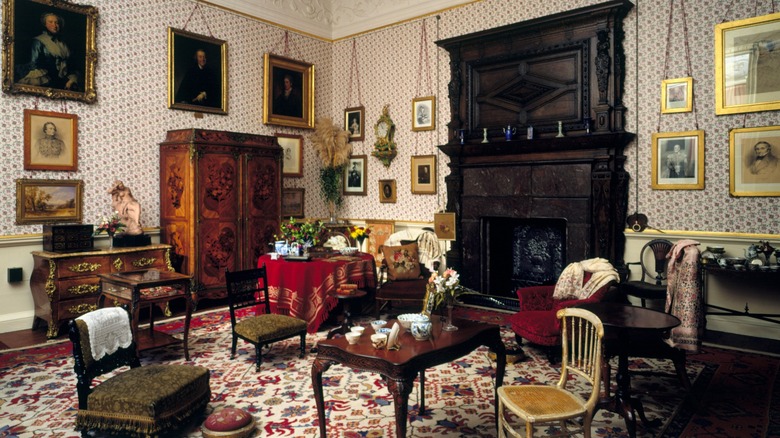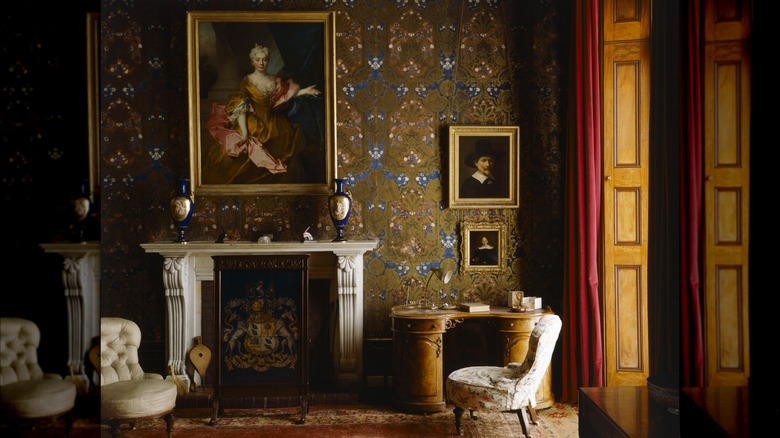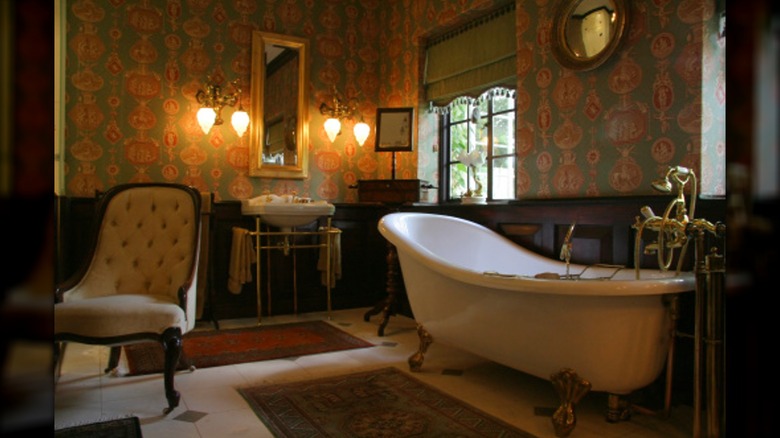The Deadly History Behind This Reemerging Home Trend May Surprise You
If you've ever considered Victorian home decor "to die for," you may have been on to something. One of the hallmarks of the period was beautiful, bright wallpaper — but unlike the wallpaper we're seeing re-emerge as a trend today, the offerings in the mid-1800s came with a very toxic ingredient — arsenic.
Speaking to The Atlantic back in 2016, Lucinda Hawkley (author of the book "Bitten by Witch Fever") explained that arsenic was used to create rich (albeit toxic) colors in wallpaper. It was particularly useful in creating very rich greens, shades that proved popular. However, as Hawkley pointed out, a study carried out by The National Archives has proven that other wallpaper colors also had high levels of arsenic in them.
Ultimately, arsenic was used to brighten up just about every color of the rainbow — as a result, homeowners flocked to cover their walls with the stuff. As Hawkley told The Atlantic, "These colors were exceptionally beautiful, and up until this point, it was not something they could achieve without the use of arsenic." We're not sure even the brightest, boldest wallpaper is worth the risk, but many home decor enthusiasts in the Victorian period thought otherwise. And yes, that was after they'd learned of the risks.
Victorians weren't fazed by the arsenic until later on
If toxic additives were found in modern home decor, regulations would require them to be removed, and fast. However, that wasn't the case at the height of the Victorian era's craze for wallpaper. In addition to authorities not acting at first (issuing suggestions rather than actual regulations), homeowners were fairly unbothered.
Speaking to CNN, Hawksley explained that "the public loved the bright colors of the new wallpapers and even when they learnt the dyes contained arsenic, they did not consider the wallpapers dangerous — as long as you did not lick them." Possibilities of kids not getting that memo notwithstanding, it's worth noting that arsenic (even when not licked) is incredibly dangerous. It was believed that arsenic could have ended up permeating into the air. Symptoms of too much exposure to arsenic included anything from stomach problems to breathing issues and arrhythmia (issues with the rate of the heartbeat). This certainly gives a new meaning to the idea of home decor taking one's breath away, albeit in the worst way.
Over time, public awareness campaigns brought about a change. Towards the end of the 19th century, homeowners and wallpaper producers were no longer willing to take the risk, and wallpapers made with arsenic were phased out. More than a century later, it is incredibly unlikely that people will knowingly put their health at risk in the name of a home decor trend.
How to recreate a Victorian look without the risk
Thanks to modern health standards, it's possible to decorate your home like it's the Victorian era in the 21st century without putting yourself, your family, or your tenants in harm's way. For starters, if you're happy to commit to a specific print, you could reach out to a local wallpaper supplier and have the print installed. Alternatively, if you're not sure the current trend of bold wallpaper is something you'll want to live with long-term (or if you're renting), there are also tons of peel-and-stick options available at a low price point. In fact, Amazon stocks bright, bold Victorian-inspired options for around $20.
Unlike the mid-1800s, when in-home bathrooms were generally reserved for those with the deepest pockets (and even then, the moisture in the room would certainly have added further risks for arsenic-infused wallpapers), these days you can create your very own Victorian-inspired bathroom without breaking the bank. In addition to patterned wallpaper, opt for a black-and-white peel-and-stick floor — Amazon stocks 32 square-foot rolls for around $35. Open to something more ornate? Amazon also stocks beautiful, patterned black-and-white flooring for just under $21.
Once upon a time, Victorian decor came with the potential for major health issues. Thankfully, the days of arsenic wall coverings are behind us. In the 21st century, you can enjoy a drop-dead gorgeous aesthetic without ... well, you get it.


